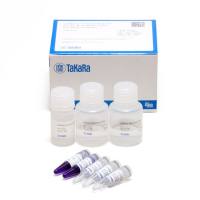Analysis of Chromosomal Translocations
Chromosomal translocations were the first target for the specific detection of residual tumor cells in bone marrow and peripheral blood. Some types of leukemia are regularly or generally associated with translocations. In chronic myelogenous leukemia (CML) and a proportion of patients with acute lymphoblastic leukemia (ALL), the t(9;22)(q34;q11) translocation leads to the fusion of the ABL gene with part of the BCR gene. Locating the primers such that the polymerase chain reaction (PCR) product spans the fusion point makes it possible to amplify sequences of the hybrid gene specifically (see Chapter 6 ). Because the breakpoints are better defined at the RNA level than at the DNA level, the primary target is the RNA, which is transcribed into cDNA by reverse transcription. (RT-PCR). In this way, a single leukemic cell can be detected from among 106 normal bone marrow or peripheral blood cells. Comparable approaches have been applied to other fusions such as the PML-RARα fusion gene in acute promyelocytic leukemia (APL). The presence of a few cells with phenotypic or genotypic features of leukemia cells after therapeutic regimens such as stem cell transplantation is know as “minimal residual disease” (MRD).
![预览]()

![四[N-邻苯二甲酰-(S)-叔亮氨酸基]二铑双(乙酸乙酯)加合物;154090-43-4;Elemental analysis(Nitrogen) 3.30 to 4.50 %;V66234-25mg](https://img1.dxycdn.com/p/s14/2025/1029/004/8672158669127143891.jpg!wh200)




